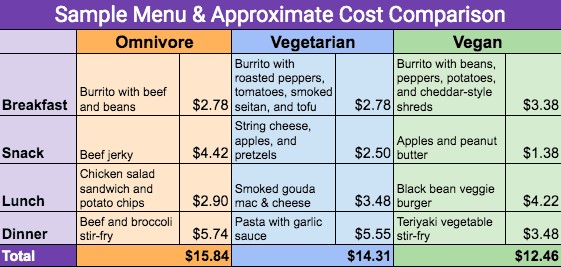The alternative meat and organic food industry has exploded. Now you can get soy slices to put in sandwiches, mock chicken nuggets, hickory BBQ riblets, soy burgers and more. But eating healthy food can increase your spending. Here are some ways you can eat healthy and cut down on grocery costs.
Cutting costs
Here are some ways to cut down on grocery costs. Instead of soy protein crumbles ($3.49 a pack), purchase black beans ($0.99 per can). Instead of fake deli meat ($3.50 a pack), you can make mock chicken salad from scratch with chickpeas ($0.99 per can plus mayonnaise and bell pepper). Then designate the more expensive foods as special purchases in the future.
Another way to decrease the cost of healthy food is to use online couponing tools like RetailMeNot and digital coupons from grocery stores, which can save you hundreds every year.
The cost of eating healthy organic food
For those who don’t have access to a farmers market or garden, eating healthy, organic food can be expensive. It means that you need to seek out food that was not made with pesticides, genetic modification or herbicides. This can be difficult, given that organic food makes up only 4% of the total food market, according to the U.S. Department of Agriculture.
Thanks to the limited supply, organic food costs an average of 24 cents more than similar non-organic food, which might not seem like much, but that can add up.
The chart below compares prices to determine just how much more expensive it is to attempt a diet consisting of healthy, organic food – and it definitely adds up. So why do people bother with organic food? The answer’s simple: It’s much healthier.
“Organic foods are the food manufacturing industry’s answer to increased toxins and pesticides in the food products they create,” says Trista Best, a registered dietitian at Balance One Supplements.
“Food ‘products’ are created in a lab and manufactured in a factory with ingredients that are processed and inflammatory,” Best adds. “All of this leads to products that are commonly associated with increased risk of chronic disease in the consumer.”
Organic eating is also associated with reduced instances of infertility, birth defects, sensitivity to allergies, non-Hodgkin lymphoma and more. The amount you save on medical costs alone could more than make up for the cost of eating organic food.
Still, it isn’t a perfect solution.
“While the items may be clear of pesticides and toxins, to an acceptable level (never entirely), not all immediately may be considered safe or healthy,” Best adds. “While organic products, especially produce, can be beneficial to health, it does not always equal better health.”
Thankfully, it isn’t the only way to stay healthy.
Vegan or vegetarian: Which saves more?
Eating vegetarian can be good on your wallet as well as your body. But vegetarians don’t have the monopoly on saving money. The vegan diet is another lifestyle that can help cut the costs of healthy food, keep your wallet full and your budget balanced.
The vegetarian lifestyle includes eating eggs and dairy, but not meat. A vegan lifestyle, on the other hand, doesn’t include meat or any food that is produced by an animal, including dairy, eggs and even honey.
Both of these diets are excellent ways to stay healthy. Vegetarians, in particular, have been found to have a lower risk of heart disease, Type 2 diabetes, certain cancers, chronic illnesses and bad cholesterol, according to Harvard Health. These benefits also apply to vegans who maintain a well-balanced diet.
For the 8% of Americans (and growing) who identify as either vegetarian or vegan, these lifestyles are a great way to stay healthy and financially secure. Though the health benefits are easily understandable, to those on the outside, it might seem strange to imagine that limiting your options could help you protect your budget.
With that in mind, here’s a daily menu for a meat eater, a vegetarian and a vegan to see the cost of eating healthy food.

You can see that it is, indeed, cheaper to eat vegan. Keep in mind food costs will go up or down depending on where you’re located, whether or not you buy organic, and whether you’re cooking for a family of four or just for one. This meal list specifically was designed for a single person based on nonorganic food.
Of course, you can be a vegetarian, a vegan or an omnivore and eat expensively or poorly. It’s all about making good choices.
How to lower the cost of eating healthy food
Planning meals, buying in season and buying in bulk can save a lot. Rather than changing your diet completely, consider following these quick tips to decrease spending and still eat healthy:
1. Shop around. Doing all of your grocery shopping at one store might be more convenient, but visiting multiple locations and franchises can be a great way to compare costs and save money.
2. Prioritize. Sometimes, it’s hard to justify buying organic avocados or sweet corn, given the extra cost and limited gain. The Environmental Working Group put out a list of the Clean 15, those fruits and vegetables that are least likely to retain pesticides, and the Dirty Dozen, which you should avoid buying when they are conventionally grown.
Given that avocados and sweet corn are members of the Clean 15, it might be worth buying the nonorganic versions and using those savings to buy organic strawberries and kale, which are included in the Dirty Dozen. This might seem like a small change, but the savings will add up and ensure you can afford the costs of eating healthy food.
3. Buy in bulk. Some Whole Foods locations have bulk foods section where you can buy organic lentils, oatmeal and more at cheaper prices. They have spices, too. Depending on your location, Costco also sells a variety of organic produce and other foods.
4. Buy only what you need. When buying fruits and vegetables, people often run the risk of purchasing more than they can reasonably eat. Though this works just fine for canned food and dried goods, produce is not meant to sit around. It’s meant to be eaten soon after picking. This could mean that you could end up throwing out much of the healthy food you’re spending your hard-earned dollars on.
You may want to make trips to the grocery store about twice each week because vegetables and fruits go bad quickly (even in the fridge)so buy only what you need for a few days.
An easy way to find out how much you need is to write down how many fruits and vegetables you eat over a three-day span. Once that’s done, take the list to the grocery store, and don’t buy any more produce than seems necessary.
If you ever want more than that, stores tend to have huge bags of organic frozen veggies that can help when you can’t make it to the grocery store and need vegetables.
The bottom line on the cost of eating healthy food
Saving money and eating healthy food aren’t mutually exclusive. Careful shopping and meal-planning can ensure that you can maintain a healthy lifestyle without ruining your financial security. And by choosing certain organic vegetarian or vegan foods, you can ensure lasting benefits to both your body and your budget.
Your Turn: Share with us ways you save on the cost of eating healthy foods.



